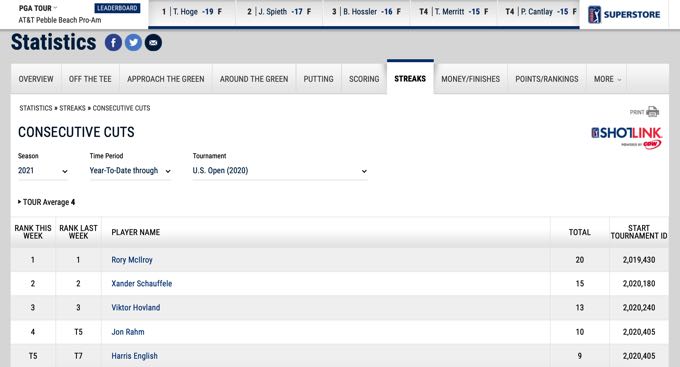 When it comes to golf tournaments, wether or not a player can make the cut is a crucial factor. Whilst it’s unlikely that a player that scrapes into the final two days of a tournament will go on to win it, if they don’t even make the cut then they’ve got no chance of doing so. The cut changes from course to course and tournament to tournament, but all of the major golfing events have one, with the exception of the Ryder Cup and similar such team competitions. Making the cut can also make a difference to how much money a player will earn.
When it comes to golf tournaments, wether or not a player can make the cut is a crucial factor. Whilst it’s unlikely that a player that scrapes into the final two days of a tournament will go on to win it, if they don’t even make the cut then they’ve got no chance of doing so. The cut changes from course to course and tournament to tournament, but all of the major golfing events have one, with the exception of the Ryder Cup and similar such team competitions. Making the cut can also make a difference to how much money a player will earn.
Betting on players making or missing the cut is an opportunity for punters to make themselves some money, too. Whilst you might assume that the best players will always make the cut, the reality is somewhat different. There have often been occasions in which even the best in the world have failed to make it to the final two days of golf at a tournament, which obviously will have had suitably long odds attached. If you can figure out which players are in poor form, you can find a way to make some money if you get it right.
What Is the Cut?
The first place to start with this particular topic is by exploring exactly what the cut is and why it is so important. Every tournament will see a huge number of players enter. In order to whittle things down, a decision is taken halfway through the tournament to get ride of around 50% of the players. With 72 holes played in most major tournaments, that means that the cut is normally carried out after 36 holes, or two day’s worth of play. Typically speaking, the cut is done at around the point where 70 players or so will be left in.
In other words, if the tournament is seeing extremely low scores, the cut might be introduced for players that have shot -12 or better in the first two days. This means that any player with -11 or worse will not be allowed to proceed further in the competition. Of course, it is not uncommon for several players to be on -12 at the conclusion of the second day of golfing, so it is any player on that score that gets to advance. As well as going off a score, it is also any player that is within ten shots of the leader, should that number be bigger.
Why Does It Matter?

Lee Trevino (Keith Allison / Wikipedia.org)
It might seem like an obvious thing to say, but making the cut is really important for a golfer. Aside from anything else, most tournaments only pay out to players that make the cut. It is usually worth in the region of £15,000, so it becomes crucial for golfers looking to make their way in the game to be in the top half of the scoreboard. On top of that, if you don’t make the cut then you stand no chance of winning the tournament as a whole, which is obviously why most players want to take part in the first place.
Whilst it will obviously be the dream of all golfers to win a tournament, there are a good number that have never managed to do so but have still made a lucrative career from consistently making the cut. By October of 2021, there were ten golfers that had made more than $10 million in prize money without ever winning an event on the PGA Tour. Those players earned more than well-known golfers, such as Lee Trevino, who won six Majors and 29 tour events, showing just how important making the cut actually is.
Look at Brett Quigley, for example. Before moving onto the Seniors Tour, now called the PGA Tour Champions, he earned more than $11 million in prize money. The surprising thing is, he never won a tournament. He achieved several top-ten finishes in 2006, which put him in 20th place in the money list that year, finishing as runner-up on three occasions. All of which happened because he made the cut consistently, putting him in a place where he could see his wallet bulging with virtually every round that he played.
Betting on the Cut
The main reason why we want to know about making the cut is that it is something that you can bet on. That means that you can bet on both a player making the cut and, conversely, a player not making the cut. The first thing that you need to know from a betting point of view is that a player’s performance will be counted if they complete three holes or more. If they don’t manage to do this, perhaps because they have withdrawn or they have been disqualified, then your bet will be made void and your stake returned to you.
Once you’re past the three hole mark, however, your bet is live and they will be considered to have missed the cut if they are disqualified or withdraw from the competition before the cut is made. If, on the other hand, they have scored in a manner that allows them to make the cut and then they withdraw or get disqualified, your bet will be classed as a winner. Though the point at which the cut is made is usually after 36 holes, this can sometimes be extended, which is something else that you need to be aware of.
Every now and then, there will be a course that is played in such a manner that there are a huge number of players on or above the score for the cut, usually 78 or more. When this happens, the cut is extended to be after 54 holes, until the chance is there to cut the players until there are just 70 playing on the final day. Those that make what is known as the Modified Cut don’t get paid unless they make the final cut for the last round of golf, but those players are counted when it comes to your bet, which is handy to know.
How to Bet on the Cut

Knowing that you can bet on players making the cut and knowing the best strategy to do so are two different things. We will always bang the drum on this site about the importance of having a plan when you place bets, given that simply winging it is one of the best ways to consistently lose money. Having a plan doesn’t necessarily mean that you’ll definitely win, such is the vagaries of betting, but it puts you in a much better position than if you’re just following your ‘gut’ or going with your feelings. Here are some ideas for betting on making the cut.
Who Makes the Cut Regularly?
Such is the nature of golf as a sport that there is plenty of information out there right now, should you know where to look. The PGA has an excellent site, filled with great statistics and pieces of information that you can look at to your heart’s content. One such titbit of info is a section on which players have made the cut the most times consecutively on individual tournaments. Did you know, for example, that by the time that the 2021 US Open came around, Rory McIlroy had made 20 consecutive cuts that year?
Look back to 2019 and you’ll see that Tommy Fleetwood made 28 consecutive cuts, which was the highest for that year. Given that the PGA Tour average is 4, you can see why a bet on Fleetwood making the cut isn’t going to present you with particularly high odds. That isn’t to say that you shouldn’t make the bet, of course, but that you’re unlikely to get particularly high returns. Brooks Koepka was the next best player, making 15 consecutive cuts, so a bet on Fleetwood not making his next cut might have been better.
A better use of the statistics available might be to head to the middle of the pack and find a player that has made, say, four consecutive cuts. Given the run that they are on, does their price to make the cut of the next tournament seem like good value? The key thing to remember when looking at these sorts of players is that you might not know much about them and they probably won’t be competing for the big prize at the end of the weekend, but all you need them to do is make the cut in order for you to win your bet.
Should You Think About Accumulators?
The best players in the world of golf are not going to miss out on the cut very often. As a result, the odds on them making the cut for any given tournament aren’t going to be particularly exciting. One thing that you can do in order to lengthen the odds of your bet a little bit is to add several players together into an accumulator, saying that all of them will make the cut and winning a larger amount of money if they manage to do so. If you add in a lesser-known player that you know is in good form, you’ll push the odds out even further.
Of course, the problem with accumulator bets is that you need them all to come in in order for your wager to be a winner. The bigger the risk you take in terms of the selections that you add to your acca, the longer the odds but the bigger the chance that one of them will let you down and you’ll end up losing your bet. Realistically, there is no sure-fire bet to place in golf and players can have bad rounds out of nowhere, but the majority of the top players will make the cut and are therefore as close to safe bets as you can place.
Betting on the Top Players Missing the Cut
It is easy to get caught up in the idea that the top players will always make the cut. They are, after all, amongst the best golfers in the world for a reason and will consistently out-perform other players in terms of consistency and reliability. Players being consistent when it comes to making the cut allows them to make money, but doesn’t always mean that they’ll actually win the tournaments. Other golfers, meanwhile, can be a little bit more mercurial, blazing hot enough to win competitions one weekend but missing the cut on others.
The best players in the world miss the cut from time-to-time, such as when the aforementioned Rory McIlroy missed the cut for the US Open in 2018. Indeed, it was the third consecutive time that he had missed the cut in that particular tournament, having only made the cut five times in the ten appearances he had had up to that point. You would be forgiven for thinking that the sensible bet would be on him making the cut, meaning that you would actually have stood a good chance of winning some decent money had you bet on him not doing so that year.
There is plenty of research that you can do when considering whether a player is likely to make the cut or not. Golfers play regularly, often taking part in competitions that aren’t just the Majors, so there is also sorts of information out there about how they do on certain courses. This means that you can look to see how well a given player does on certain course types, taking that information away with you and considering whether it makes them more or less likely to make the cut at the next tournament they’re playing.
How the course is set up is one of the key factors on this front. Take Augusta, for example. The home of the US Masters is used as the location for the tournament every year, but that doesn’t meant that the setup will always be the same. They can move the flag position, say, or play around with the bunkers. The course is usually set-up to favour right-handed players that can draw their shots, so if you’re looking at a left-hander that struggles with that then they are likely to have trouble making the cut at Augusta.
Look for Value
It might seem obvious, but when you’re looking at cut betting, you want to try to find some value. The players that are likely to be in the top ten will all be mostly quite well-known and will have short odds for even winning the thing at the start of proceedings, let alone making the cut. In truth, even an outside for the competition will probably be Evens or only slightly better for making the cut, such is the extent to which bookmakers view it as something akin to a flip of a coin, so betting on them isn’t always the most sensible of choices.
That being said, it is difficult to find bets with plenty of value in cut betting, which is why we’ve already suggested considering placing accumulator bets to boost it out a bit. Ultimately, though, there are 70 or more players there to choose from when it comes to making the cut, so combining research with your understanding of the market can put you in a position where you can have a bet on a player making the cut that might be a little longer than expected. Failing that, there’s always the bet on the top players missing the cut that we’ve mentioned.
